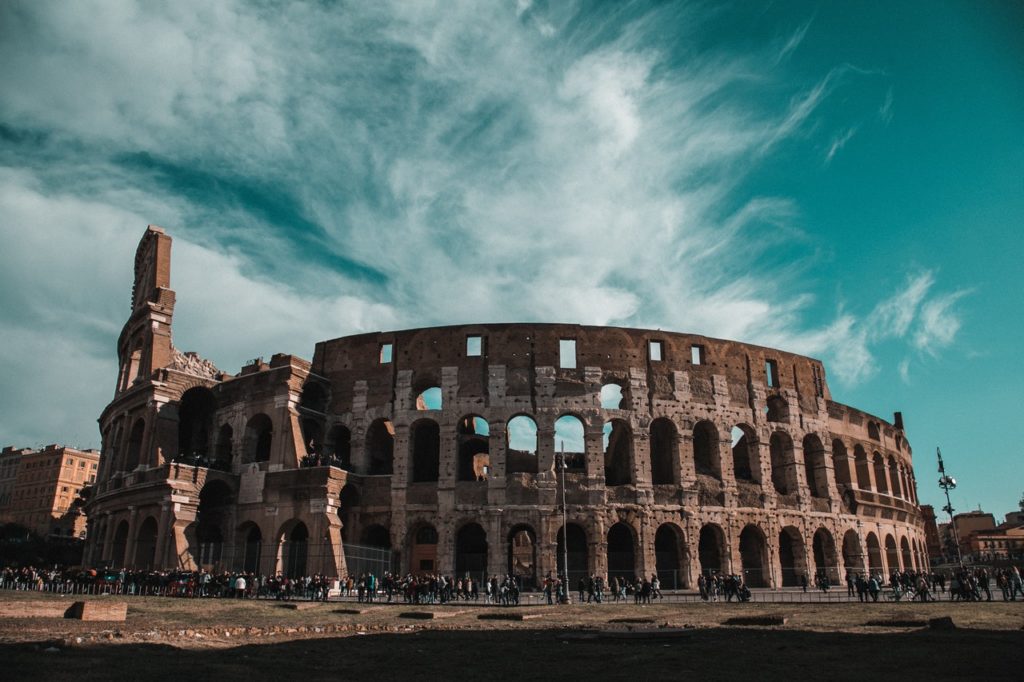
I learned this today. The most famous building in Rome is probably the Colosseum, but it wasn’t called the Colosseum until about 600 years after it was built.
The Colosseum was built between 69 and 80 AD. It was ordered by Emperor Vespasian. It was built on land that Emperor Nero had confiscated from the people and building it was a way for Vespasian to show that he was giving back to his people. It was built with money taken from the Jewish Temple during the first Jewish-Roman war, according to an inscription found at the site.
Vespasian died in 79 AD, so he never got to see the Colosseum. It was finished under his son, Emperor Titus, and was opened in 80 AD.
The Colosseum was used for gladiatorial fights, mock battles, public executions, animal hunts, and it could even be flooded to show mock sea battles. It continued to be used even after the Roman Empire started to fall from 375 AD. In the 6th to 12th centuries, it was being used for housing and workshops. There are big spaces in the structure that lend themselves perfectly to being used as houses. In 1349, there was a great earthquake that damaged the Colosseum. A lot of the stone was taken to build other buildings. in the 14th century, the Colosseum became a Christian shrine until the 19th century.
When it was built, the Colosseum was simply known as “Amphitheater”. An amphitheater is an open-air stadium used for entertainment. The word comes from ancient Greek, “Amphitheatron”. “Amphi” means “on both sides” and “theatron” means “place for viewing”.
Later on, there is a chance that the Colosseum was called “Amphitheatrum Flavium”, but there is no real evidence for this. If it was, it would have been named in honor of the Flavian dynasty. These were the three Emperors who started the building of the Colosseum and patronized it. They were Vespasian and his two sons Titus and Domitian. There is also a theory that the building was called “Amphitheatrum Caseareum” after Caesar. This could have been Julius Ceasar, but it was probably just used to mean “Emperor”.
In 128 AD, a giant statue of Nero was moved to stand beside the Colosseum. This statue was modeled on the Colossus of Rhodes, one of the original seven wonders of the world. That statue was supposed to be 33m high, roughly the same height as the Statue of Liberty without her pedestal. The Colossus of Nero was said to be 30m high. Emperor Nero had it built to commemorate himself (he was not a modest person) but, after he died, Emperor Vespasian added a sunray crown and modified the statue to be the Roman sun god Sol. Emperor Hadrian had the statue moved from the Domus Aurea, the imperial villa complex, to near the Colosseum.
It is not known when the name Colosseum was first used, but it was definitely in use by the 6th century. The most likely theory is that the name came from its association with the giant statue of Nero. The statue was known as the Colossus Solis (Giant Sun god). Colosseum is the noun form of the adjective colossus. By the year 1000, Colosseum was the accepted name for the amphitheater.
In the 8th century, the Venerable Bede wrote his famous quote, “as long as the Colossus stands, so shall Rome; when the Colossus falls, Rome shall fall; when Rome falls, so falls the world.” Many people think he was writing about the Colosseum, but he was actually writing about the Colossus of Nero. The statue did fall. Earthquakes brought it down, the same as the Colossus of Rhodes, but the world hasn’t fallen yet.
So, the Colosseum was originally just called the amphitheater. In 128 AD, a giant statue of Nero, the Colossus of Nero, renamed the Colossus of Sol, was moved to stand next to the amphitheater. The name Colosseum was coined because it is the noun form of the adjective Colossus. The building was named because of the statue and that name started to catch on by the 6th century, long after the building had been built. And this is what I learned today.
Sources
https://en.wikipedia.org/wiki/Colosseum
https://www.the-colosseum.net/history/h1.htm
https://en.wikipedia.org/wiki/Colossus_of_Nero
https://www.kissfromitaly.com/en/blog/how-did-the-colosseum-get-its-name
